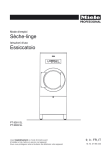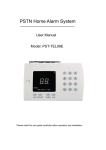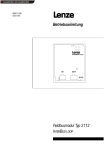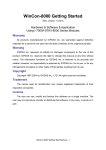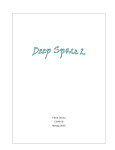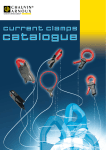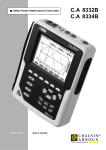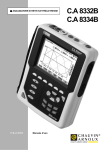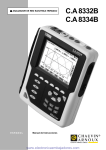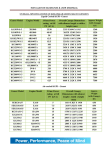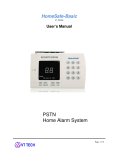Download Miele PT 8333 Operating instructions
Transcript
Operating instructions Dryers PT 8251 + COP PT 8331 + COP PT 8401 To avoid the risk of accidents or damage to the machine it is essential to read these instructions before installing, commissioning and using it for the first time. PT 8253 PT 8333 PT 8403 PT 8503 PT 8803 en - GB M.-Nr. 07 713 210 Gas-heated machines Safety precautions to take if you smell gas – Turn off the gas emergency control valve immediately. This is usually located near the gas meter. – Eliminate all sources of ignition in a safe manner. Do not smoke, light cigarette lighters or matches. – Do not operate electrical lights or switches, i.e. do not switch them "On" or "Off". – Open all windows and doors to ventilate the area. – If the smell of gas persists, evacuate the building. In the UK you must now: - Call the Gas Emergency Contact Centre (Tel: 0 800 111 999) - For any gas work in the UK always use a Gas Safe registered engineer. In other countries please follow relevant country specific procedures on gas. 2 Contents Warning and Safety instructions . . . . . . . . . . . . . . . . . . . . . . . . . . . . . . . . . . . . . . . . . . . . . . . . . . . . . . . . . . . . . . . 4 Caring for the environment . . . . . . . . . . . . . . . . . . . . . . . . . . . . . . . . . . . . . . . . . . . . . . . . . . . . . . . . . . . . . . . . . . . 6 Guide to the machine . . . . . . . . . . . . . . . . . . . . . . . . . . . . . . . . . . . . . . . . . . . . . . . . . . . . . . . . . . . . . . . . . . . . . . . . 7 Description of dryers PT 8251, 8331, 8401 . . . . . . . . . . . . . . . . . . . . . . . . . . . . . . . . . . . . . . . . . . . . . . . . . . . . . . . 8 Description of dryers PT 8253, 8333, 8403, 8503, 8803 . . . . . . . . . . . . . . . . . . . . . . . . . . . . . . . . . . . . . . . . . . . . . 9 Drying. . . . . . . . . . . . . . . . . . . . . . . . . . . . . . . . . . . . . . . . . . . . . . . . . . . . . . . . . . . . . . . . . . . . . . . . . . . . . . . . . . . . 10 Sort the laundry. . . . . . . . . . . . . . . . . . . . . . . . . . . . . . . . . . . . . . . . . . . . . . . . . . . . . . . . . . . . . . . . . . . . . . . . . . . . . 10 Drying. . . . . . . . . . . . . . . . . . . . . . . . . . . . . . . . . . . . . . . . . . . . . . . . . . . . . . . . . . . . . . . . . . . . . . . . . . . . . . . . . . . . 11 Before using for the first time . . . . . . . . . . . . . . . . . . . . . . . . . . . . . . . . . . . . . . . . . . . . . . . . . . . . . . . . . . . . . . . . . . 11 Switch the machine on and load the drum . . . . . . . . . . . . . . . . . . . . . . . . . . . . . . . . . . . . . . . . . . . . . . . . . . . . . . . . 11 Dryers PT 8251, 8331, 8401 . . . . . . . . . . . . . . . . . . . . . . . . . . . . . . . . . . . . . . . . . . . . . . . . . . . . . . . . . . . . . . . . . . 12 Selecting a temperature . . . . . . . . . . . . . . . . . . . . . . . . . . . . . . . . . . . . . . . . . . . . . . . . . . . . . . . . . . . . . . . . . . . . . . 12 Selecting a drying duration. . . . . . . . . . . . . . . . . . . . . . . . . . . . . . . . . . . . . . . . . . . . . . . . . . . . . . . . . . . . . . . . . . . . 12 Programme finished . . . . . . . . . . . . . . . . . . . . . . . . . . . . . . . . . . . . . . . . . . . . . . . . . . . . . . . . . . . . . . . . . . . . . . . . . 12 Dryers PT 8253, 8333, 8403, 8503, 8803 . . . . . . . . . . . . . . . . . . . . . . . . . . . . . . . . . . . . . . . . . . . . . . . . . . . . . . . . 13 Selecting a programme . . . . . . . . . . . . . . . . . . . . . . . . . . . . . . . . . . . . . . . . . . . . . . . . . . . . . . . . . . . . . . . . . . . . . . 13 Lowering the temperature. . . . . . . . . . . . . . . . . . . . . . . . . . . . . . . . . . . . . . . . . . . . . . . . . . . . . . . . . . . . . . . . . . . . . 13 Programme finished . . . . . . . . . . . . . . . . . . . . . . . . . . . . . . . . . . . . . . . . . . . . . . . . . . . . . . . . . . . . . . . . . . . . . . . . . 13 Drying. . . . . . . . . . . . . . . . . . . . . . . . . . . . . . . . . . . . . . . . . . . . . . . . . . . . . . . . . . . . . . . . . . . . . . . . . . . . . . . . . . . . 14 Interrupting a programme. . . . . . . . . . . . . . . . . . . . . . . . . . . . . . . . . . . . . . . . . . . . . . . . . . . . . . . . . . . . . . . . . . . . . 14 Adding or removing items . . . . . . . . . . . . . . . . . . . . . . . . . . . . . . . . . . . . . . . . . . . . . . . . . . . . . . . . . . . . . . . . . . 14 PT 8251, 8331 COP . . . . . . . . . . . . . . . . . . . . . . . . . . . . . . . . . . . . . . . . . . . . . . . . . . . . . . . . . . . . . . . . . . . . . . . . . 15 Control panel PT 8251, 8331 Profitronic B COP (Coin Operation) . . . . . . . . . . . . . . . . . . . . . . . . . . . . . . . . . . . . . . 15 Selecting a temperature . . . . . . . . . . . . . . . . . . . . . . . . . . . . . . . . . . . . . . . . . . . . . . . . . . . . . . . . . . . . . . . . . . . . . . 15 At the end of the drying duration . . . . . . . . . . . . . . . . . . . . . . . . . . . . . . . . . . . . . . . . . . . . . . . . . . . . . . . . . . . . . . . 15 Reprogramming . . . . . . . . . . . . . . . . . . . . . . . . . . . . . . . . . . . . . . . . . . . . . . . . . . . . . . . . . . . . . . . . . . . . . . . . . . . 16 Reprogramming individual drying programmes (Changing the Standard options) . . . . . . . . . . . . . . . . . . . . . . . . . . . . . . . . . . . . . . . . . . . . . . . . . . . . . . . . . . . . . . 16 Example of reprogramming PT 8251, 8331, 8401 Profitronic B Timed programme machines. . . . . . . . . . . . . . 16 Example of reprogramming PT 8253, 8333, 8403, 8503, 8803 Profitronic B Plus Residual moisture programme machines . . . . . . . . . . . . . . . . . . . . . . . . . . . . . . . . . . . . . . . . . . . . . . . . . . . . . . 16 Programmable functions. . . . . . . . . . . . . . . . . . . . . . . . . . . . . . . . . . . . . . . . . . . . . . . . . . . . . . . . . . . . . . . . . . . . . . 17 Problem solving guide . . . . . . . . . . . . . . . . . . . . . . . . . . . . . . . . . . . . . . . . . . . . . . . . . . . . . . . . . . . . . . . . . . . . . . 18 Fault messages. . . . . . . . . . . . . . . . . . . . . . . . . . . . . . . . . . . . . . . . . . . . . . . . . . . . . . . . . . . . . . . . . . . . . . . . . . . . . 18 Other messages . . . . . . . . . . . . . . . . . . . . . . . . . . . . . . . . . . . . . . . . . . . . . . . . . . . . . . . . . . . . . . . . . . . . . . . . . 18 Cleaning and care . . . . . . . . . . . . . . . . . . . . . . . . . . . . . . . . . . . . . . . . . . . . . . . . . . . . . . . . . . . . . . . . . . . . . . . . . . 19 Fluff filter . . . . . . . . . . . . . . . . . . . . . . . . . . . . . . . . . . . . . . . . . . . . . . . . . . . . . . . . . . . . . . . . . . . . . . . . . . . . . . . . . . 19 Installation and connection . . . . . . . . . . . . . . . . . . . . . . . . . . . . . . . . . . . . . . . . . . . . . . . . . . . . . . . . . . . . . . . . . . 20 Levelling the machine. . . . . . . . . . . . . . . . . . . . . . . . . . . . . . . . . . . . . . . . . . . . . . . . . . . . . . . . . . . . . . . . . . . . . . . . 21 Installation on a raised plinth . . . . . . . . . . . . . . . . . . . . . . . . . . . . . . . . . . . . . . . . . . . . . . . . . . . . . . . . . . . . . . . . . . 21 Fitting the language insert (Programme selection panel). . . . . . . . . . . . . . . . . . . . . . . . . . . . . . . . . . . . . . . . . . . . . 21 Payment system . . . . . . . . . . . . . . . . . . . . . . . . . . . . . . . . . . . . . . . . . . . . . . . . . . . . . . . . . . . . . . . . . . . . . . . . . . . . 21 Communication module XKM RS232 . . . . . . . . . . . . . . . . . . . . . . . . . . . . . . . . . . . . . . . . . . . . . . . . . . . . . . . . . . . . 21 Electrical connection . . . . . . . . . . . . . . . . . . . . . . . . . . . . . . . . . . . . . . . . . . . . . . . . . . . . . . . . . . . . . . . . . . . . . . . . 22 Air inlet and exhaust connection . . . . . . . . . . . . . . . . . . . . . . . . . . . . . . . . . . . . . . . . . . . . . . . . . . . . . . . . . . . . . . . 22 Steam connection . . . . . . . . . . . . . . . . . . . . . . . . . . . . . . . . . . . . . . . . . . . . . . . . . . . . . . . . . . . . . . . . . . . . . . . . . . . 22 Gas connection. . . . . . . . . . . . . . . . . . . . . . . . . . . . . . . . . . . . . . . . . . . . . . . . . . . . . . . . . . . . . . . . . . . . . . . . . . . . . 22 Technical data . . . . . . . . . . . . . . . . . . . . . . . . . . . . . . . . . . . . . . . . . . . . . . . . . . . . . . . . . . . . . . . . . . . . . . . . . . . . . 23 Explanation of symbols on the data plate . . . . . . . . . . . . . . . . . . . . . . . . . . . . . . . . . . . . . . . . . . . . . . . . . . . . . . 24 3 Warning and Safety instructions Explanation of the Warning and Safety symbols on the machine It is essential to read these operating instructions. – items soiled with grease or oil which have not been properly cleaned beforehand. Use heavy-duty detergents where necessary to clean heavily soiled garments, e.g. workwear. If necessary consult the detergent manufacturer for advice. With sensitive fabrics there may be a danger of them self igniting if dried for too long. They should be removed as soon as the programme has finished or if there is a power cut. Keep a fire extinguisher near the machine at all times. Please refer to specific instructions, e.g. Installation instructions ~ Do not unload laundry from the drum until the Caution, hot surfaces. ~ Check that all pockets of workwear etc are empty Caution, voltage up to 1000 volts. cooling down phase has been completed. Hot laundry can self ignite and cause a fire when folded or put away. to avoid the danger of inflammable objects, e.g. cigarette lighters, matches, candles or cosmetics being placed in the dryer. ~ If the dryer is installed in a public area the owner must ensure that it can be operated safely. Earthing Technical and electrical safety ~ This machine must only be installed and commissioned by a Miele authorised technician. To avoid the risk of accidents and damage to the machine read the operating instructions carefully before using it for the first time. They contain important information about the installation, safety, use and maintenance of the machine. Keep them in a safe place and ensure that new users are familiar with the content. Pass them on to any future owner of the machine. Correct application ~ This dryer must only be used for drying articles which were washed in water and which have a care label stating that the article is suitable for machine drying. ~ To prevent the risk of fire, the following must not be dried in this tumble dryer (with the exception of those fabrics which can be dried in the Special Programmes specifically designed for them): – fabrics which contain a large proportion of rubber, foam rubber or rubber-like materials. – items which have been treated with inflammable cleaning agents. – items which have been splashed with hair lacquer, hair spray, nail varnish remover or similar substances. – items which have been soiled with oils or residues containing grease (kitchen oils, cosmetics etc.). – items soiled with wax or other chemicals (e.g. mops and floor cloths). – items with damaged padding or fillings (e.g. pillows, jackets). 4 ~ The electrical safety of this machine can only be guaranteed if connected to a correctly installed earthing system on site. It is most important that this basic safety requirement is present and tested regularly, and where there is any doubt, the on-site electrical wiring should be inspected by a qualified electrician. The manufacturer cannot be held liable for the consequences of an inadequate earthing system (e.g. electric shock). ~ The machine is only completely isolated from the electricity supply either when it is switched off at the isolator switch or the mains fuse has been withdrawn. ~ Repairs to electrical and gas heated appliances should only be carried out by a suitably qualified and competent person in accordance with local and national safety regulations. Repairs and other work by unqualified persons could be dangerous. The manufacturer cannot be held liable for unauthorised work. ~ Faulty components must only be replaced by genuine Miele original spare parts. Only when these parts are fitted can the safety standards of the machine be guaranteed. ~ This machine must not be operated in the same room as dry cleaning machines which use solvents containing chlorofluorocarbons (CFCs). Escaping vapours break down during combustion into hydrochloric acid which can have a detrimental effect on both the laundry and the machine. Even when such machines are installed in separate rooms, care should be taken to ensure that no exchange of air can take place. Warning and Safety instructions ~ The dryer must have a constant supply of fresh air. Vapours containing chlorine, fluorine or other solvents must not be able to reach the dryer. ~ The ventilation inlet to the dryer is located at the back of the machine. It must not be blocked or hindered in any way. Do not cover the machine lid with cloths or similar items. ~ Benzine, petrol, paraffin or any easily flammable substance must not be stored or used near the tumble dryer. Fire and explosion risk. ~ To ensure the correct performance of the machine and to prevent the risk of faults and fire, it is important to check the machine and carry out maintenance on a regular basis. Use ~ This tumble dryer must only be used when it is connected to a suitable ducting system. The installation site must be adequately ventilated. ~ This tumble dryer is not intended for use by per- ~ Do not use the machine without the built-in fluff filter in place. Fire risk. A damaged fluff filter must be replaced before the machine is used again. Otherwise fluff and lint will cause a blockage in the airways, the heating and the vent ducting, and the correct functioning of the machine cannot be assured. ~ Cleaning and disinfecting agents often contain chlorine-based substances. Do not let such agents come into contact with the stainless steel surfaces, as the chlorine can have a corrosive effect and cause rust. Use chlorine-free agents for washing and disinfecting and also for cleaning stainless steel surfaces to protect them from corrosion. If in doubt, confirm with the manufacturer that their product is suitable. If any agent containing chlorine comes into contact with the stainless steel surfaces, wipe it away immediately with clean water. Then dry with a soft cloth. ~ Do not use a pressure washer or hose to clean the machine. sons (including children) with reduced physical, sensory or mental capabilities, or lack of experience or knowledge, unless they are supervised whilst using it or have been shown how to use it by a by a person responsible for their safety. ~ The gas mains connection point and the gas con- ~ Keep children away from the tumble dryer at all times. It is not a toy! To avoid the risk of injury do not allow them to play on or near it or to play with the controls. Supervise children whilst you are using it. ~ Warning. After commissioning the machine, and ~ Always close the drum door after use to avoid: – the risk of children and small animals climbing into the drum and endangering their lives. ~ Do not use a machine with damaged controls or cables. These must be repaired before it is used again. ~ Do not damage, remove or bypass the safety features, fixtures and control elements of this machine. ~ Any removable outer panels must be back in place, and all moving or electrical parts shielded before the machine is switched on. ~ Whilst the dryer is in use the porthole glass and drum door frame can become very hot. Laundry will also be very hot if you remove it early. Gas heated dryers nection to the machine should be switched off for all cleaning and maintenance work and in the event of a fault. after any maintenance, conversion or repair work all components carrying gas from the gas tap to the burners should be tested for leakage. Test points on the gas tap and the burner are particularly important. The machine should be tested with the burner switched on and switched off. Using accessories ~ Accessory parts may only be fitted when expressly approved by Miele. If spare parts or accessories from other manufacturers are used, this will invalidate the guarantee, and Miele cannot accept liability. Disposing of your old machine ~ Before disposing of an old machine, first make the door lock unusable. This way you will prevent children from accidentally locking themselves in and endangering their lives. ~ To prevent the risk of injury or scalding components carrying steam must not be touched. ~ Always make sure that the drum is stationary before reaching into the machine to remove laundry. Reaching into a moving drum is extremely dangerous. Keep these instructions in a safe and accessible place. ~ Take care near the drum door hinges and the fluff filter compartment flap. Danger of injury. Ensure that you always use the handles. ~ The drum door must be able to be opened to its fullest extent. This area must not be restricted by doors or structural features. 5 Caring for the environment Disposal of the packing material Tips on saving energy The transport and protective packing has been selected from materials which are environmentally friendly for disposal. Make sure that your laundry is thoroughly spun before drying. This saves time and energy. Rather than just throwing these materials away, please ensure they are recycled. ,Ensure that any plastic wrappings, bags, etc are disposed of safely and kept out of the reach of babies and young children. Danger of suffocation. Disposing of your old machine Electrical and electronic machines often contain materials which, if handled or disposed of incorrectly could be potentially hazardous to human health and to the environment. They are, however, essential for the correct functioning of your machine. Please do not therefore dispose of it with your household waste. Please dispose of it at your local community waste collection / recycling centre or contact your Dealer for advice. Ensure that it presents no danger to children while being stored for disposal. See the "Warning and Safety" section of this booklet for further details. 6 Rinsing the laundry using hot water in the final rinse helps to reduce the residual moisture level, and the residual heat in the laundry will help keep processing time down, thus saving energy. Sort textiles according to: - fabric and weave, - drying level required, - residual moisture levels. For greater economy dry a full load. Underloading is uneconomical. Overloading will impair the drying result and the laundry finish. Ensure that the room is well ventilated. Guide to the machine b f a j c d g h e i a Emergency stop switch f Electrical connection Only for use in an emergency. Once the danger is no longer present, turn the grooved disc clockwise to disengage the switch. g Air intake Do not use the Emergency stop switch to turn off the dryer in normal use. h Exhaust connection b Control panel i Equipotential bonding c Drum door j Communication slot Pull the door handle to open the drum door. d Access to fluff filter Pull the handle to open the fluff filter compartment. e 4 adjustable screw feet 7 Description of dryers PT 8251, 8331, 8401 Control panel PT 8251, 8331, 8401 Profitronic B Timed programmes 1 3 1 Segment display - Time 4 Venting system fault indicator 7 Time selection rotary control 2 4 5 6 7 2 Programme sequence display 5 Fluff filter fault indicator 8 On/Off switch 8 3 Temperature selection button 6 START/STOP button Mains On/Off switch s Segment display Switches the machine on or off. Before the start of a programme this shows the selected drying duration in minutes. After the start of a programme it shows the time left to the end of the programme. It also shows fault messages, see "Problem solving guide". It can also show h for "Peak load cut-out" (optional). Temperature selection button For setting the required drying temperature - Cold, Low, Medium, High. The corresponding LED will light up. Time selection rotary dial u Programme durations of up to 60 minutes can be selected in five minute stages from 5 to 60 minutes to suit different fabric types and depending on how the laundry is to be further processed. The corresponding LED will light up. The drying duration can also be altered during the drying process. START/STOP button Press the Start/Stop button to start or stop the drying programme. Programme sequence display The programme sequence is displayed in three stages. The stage the programme is at will be highlighted in yellow. ! Drying L Cooling down O Programme finished / Anti-crease Check venting system 0 fault indicator This will light up if there is a problem with the venting system. Clean the fluff filter W fault indicator This light up when the fluff filter needs to be cleaned. 8 Description of dryers PT 8253, 8333, 8403, 8503, 8803 Control panel PT 8253, 8333, 8403, 8503, 8803 Profitronic B Plus Residual moisture programmes 1 3 2 4 5 1 Segment display - Residual moisture 3 Low temperature (additional option) button 5 Fluff filter fault indicator 7 Programme selection rotary control 6 7 8 2 Programme sequence display 4 Venting system fault indicator 6 START/STOP button 8 On/Off switch Mains On/Off switch s Segment display Switches the machine on or off. Before the start of a programme this shows the residual moisture which has been allocated to the programme as a %. After the start of a programme it shows the residual moisture which is currently in the laundry until the programme is finished. It also shows fault messages, see "Problem solving guide". It can also show h for "Peak load cut-out" (optional). Low temperature (additional option) button K Lowers the drying temperature (by approx. 20°C). Use for delicate fabrics (e.g. synthetics). The LED will light up. Programme selection rotary control For selecting the drying programme. Programme sequence display A: Minimum iron B: Cottons Drying Moisture 10% Moisture 20% Delicates Woollens Timed drying warm Drying plus Drying Moisture 20% Moisture 25% Moisture 40% Timed drying cold The programme sequence is displayed in three stages. The stage the programme is at will be highlighted in yellow. ! Drying L Cooling down O Programme finished / Anti-crease START/STOP button Press the Start/Stop button to start or stop the drying programme. Check venting system 0 fault indicator This will light up if there is a problem with the venting system. Clean the fluff filter W fault indicator This light up when the fluff filter needs to be cleaned. 9 Drying Sort the laundry Not all textiles are suitable for machine drying. Please read the instructions given on the garment care label. The meaning of the care symbols: q = Dry at normal temperature r = Dry at low temperature s = Do not tumble dry Sort the laundry according to fibre type and weave to ensure even drying. ,There is a danger of fire with the following and they must not be dried in this machine (with the exception of those fabrics which can be dried in the Special Programmes specifically designed for them): - articles containing foam rubber, rubber or rubber like materials, - articles which have been treated with inflammable cleaning agents, - articles which have been splashed with hair lacquer, hair spray, nail varnish remover etc., - articles soiled with oils, grease and other residues e.g. kitchen linen and spa linen, - articles contaminated with residues such as wax or chemicals, e.g. mops and floor cloths, - articles with damaged padding - articles soiled with oils or grease which have not been sufficiently washed beforehand. Use heavy-duty detergents where necessary to clean very dirty garments, e.g. workwear. If necessary consult the detergent manufacturer for advice. The following textiles should not be machine dried: Woollens and wool blends as these tend to matt and shrink. Partially dry these using in the "Woollens" programme. Pure linen tends to roughen if tumble dried. Please follow instructions given on the care label. Important: Textiles with large metal accessories such as buckles, hooks and zip tags should be placed in a laundry bag or a pillow case before drying. This is to protect the drum from scratches and dents during drying. Garments with closed metal zips can cause the sensor electrodes in the drum ribs to be bridged. This can cause the drying process to go on for too long, or to not finish at all. Open zips before drying. Loopknit and woven textiles (e.g. T-shirts and underwear) have a tendency to shrink depending on their quality. This is made worse by over-drying. Do not use the "Cottons dry plus" for these textiles. 10 Starched laundry can be machine dried. Select the most appropriate programme for ironing by hand or machine. Sort the laundry according to the level of dryness required. It is not necessary to sort according to size. Duvet covers and pillow cases should be closed to prevent smaller items rolling up inside them. For greater economy dry a full load. Underloading is uneconomical. Overloading will impair the drying result and the laundry finish. Rinsing the laundry using hot water in the final rinse helps to reduce the residual moisture level, and the residual heat in the laundry will help keep processing time down, thus saving energy. Drying This machine must only be installed and commissioned by a Miele authorised technician. For gas heated machines in the UK, this must be carried out by a Gas Safe registered engineer. Before using for the first time Before loading the dryer with laundry, wipe the internal drum surface with a soft, dry cloth. Switch the machine on and load the drum ^ Open all stopcocks for water, gas and steam as applicable. ^ Switch on the on-site mains electricity switch. ^ Press the mains On/Off switch s ^ Open the drum door. ^ Load the drum. The pre-sorted laundry should be loaded loosely in the drum. Make sure any dispensing aids such as detergent balls have been removed from the laundry. Max. load (dry weight of laundry) PT 8251 8253 8331 8333 8401 8403 8503 8803 Drum volume in litres 250 325 400 500 800 Cottons 10-13 kg 13-16 kg 16-20 kg 20-25 kg 32-40 kg Minimum iron 6.2 kg 8.2 kg 10 kg 12.5 kg 20 kg 5 kg 8 kg 10 kg 16 kg Delicates 2.5 kg 3.3 kg 4 kg Woollens 5 kg 6.6 kg 8 kg To prevent the risk of damaging laundry, make sure it cannot be trapped when the door is closed. ^ Close the drum door. 11 Dryers PT 8251, 8331, 8401 Selecting a temperature High Medium ! Drying L Cooling down O Programme finished / Anti-crease Low Cold ^ Press the temperature selection button and select the required drying temperature Cold, Low, Medium, High. The corresponding LED will light up. Cottons Cotton and linen fabrics can be dried at any temperature, including High. Minimum iron Synthetic and mixed fibre fabrics can be dried at a maximum of Medium. Delicates Dry synthetic and rayon fabrics using the Low temperature setting. Use the Cold temperature for airing textiles. Selecting a drying duration ^ Set the drying duration you require with the u Time selection rotary dial. The corresponding LED will light up. The segment display shows the selected programme duration in minutes. ^ Press the START/STOP button. The drying programme will begin. The segment display shows the time left until the end of the programme in minutes. 12 The programme sequence is displayed in three stages. The stage the programme is at will be highlighted in yellow. Programme finished At the end of the programme a buzzer will sound to indicate that it has finished. " 0 " will appear in the segment display. This is followed by a cooling-down phase. ! Drying L Cooling down O Programme finished / Anti-crease If laundry is not removed as soon as the programme finishes, the anti-crease phase will begin. The drum will rotate at brief intervals to keep the laundry from creasing. Dryers PT 8253, 8333, 8403, 8503, 8803 Selecting a programme Lowering the temperature ^ When drying delicate fabrics (such as acrylic), press the K Low temperature additional option button. ^ Press the START/STOP button. The drying programme will begin. The segment display will show the residual moisture which is currently in the laundry until the programme is finished. ^ Use the programme selector rotary dial to select the programme you want. The corresponding LED will light up. The segement display shows the residual moisture which has been allocated to the programme as a %. Cottons For drying cotton and linen fabrics - Drying plus 0 % residual moisture + 10 mins - Drying 0 % residual moisture - Moisture 20 % 20 % residual moisture - Moisture 25 % 25 % residual moisture - Moisture 40 % 40 % residual moisture Minimum iron For drying synthetic and mixed fibre fabrics - Drying 0 % residual moisture - Moisture 10 % 10 % residual moisture - Moisture 20 % 20 % residual moisture Delicates 20 % residual moisture For drying synthetic and rayon fabrics. Woollens 5 minute drying duration For drying machine washable woollen and wool blend garments. ! Drying L Cooling down O Programme finished / Anti-crease The programme sequence is displayed in three stages. The stage the programme is at will be highlighted in yellow. Programme finished At the end of the programme a buzzer will sound to indicate that it has finished. " 0 " will appear in the segment display. This is followed by a cooling-down phase. ! Drying L Cooling down O Programme finished / Anti-crease If laundry is not removed as soon as the programme finishes, the anti-crease phase will begin. The drum will rotate at brief intervals to keep the laundry from creasing. Timed drying warm air 20 minutes drying duration at a high temperature Timed drying cool air 15 minute duration for airing garments. 13 Drying At the end of the programme: Interrupting a programme ^ Open the drum door. The programme is interrupted by: - pressing the mains On/Off switch s, - opening the drum door, - opening the fluff compartment flap. ^ Unload the drum. Make sure nothing is left behind in the drum. If items are left in the dryer, they could be damaged by overdrying when the dryer is next used. ,Do not unload laundry from the drum until the cooling down phase has been completed. Hot laundry can self-ignite and cause a fire when folded or put away. ^ Check the fluff filter and clean if necessary. Close the fluff filter compartment flap to prevent anyone tripping over it. To continue the programme: Press the mains On/Off switch s, or close the drum door or fluff compartment flap. The remaining drying duration or the target residual moisture level will flash in the segment display, and a cooling-down phase will follow the end of the programme. ^ Press the START/STOP button or remove the laundry straight away. Adding or removing items If the dryer is still switched on (and the drum door is closed) it will start up again briefly after an interval of 30 minutes for safety reasons. The drum door can be opened during a drying programme to remove or add items if necessary. ,Always make sure that the drum is stationary before reaching into the machine to remove laundry. Reaching into a moving drum is extremely dangerous. To continue the drying programme: ^ Close the drum door. The remaining drying duration or the target residual moisture level will flash in the segment display. The fan will switch itself on automatically if the temperature in the drum is too high. ^ Press the START/STOP button to continue the programme. If no more laundry is to be processed: ^ Close the drum door. ^ Switch the dryer off by pressing the mains On/Off switch s ^ Switch off the on-site mains switch. ^ Close all stopcocks for water, gas and steam as applicable. 14 PT 8251, 8331 COP Control panel PT 8251, 8331 Profitronic B COP (Coin Operation) 1 3 2 4 5 6 7 1 Segment display - Time 2 Programme sequence display 4 Venting system fault indicator 5 Fluff filter fault indicator 3 Temperature selection button 6 START/STOP button 7 On/Off switch Time selection can be controlled by a C 4065 coin control unit or other type of payment system. ^ Press the mains On/Off switch s ^ Load the drum and close the door. Selecting a temperature High At the end of the drying duration ! Drying L Cooling down O Programme finished / Anti-crease Medium At the end of the drying duration the "Drying" and "Programme finished" programme sequence stage symbols will flash. "Cooling down" will light up and the cooling down phase will begin. Low Cold ^ Press the temperature selection button and select the required drying temperature Cold, Low, Medium, High. The corresponding LED will light up. Cold For airing fabrics Low Delicates, synthetic fibre and rayon fabrics Medium Minimum iron, synthetic and mixed fibre fabrics High Cottons, cotton and linen fabrics ^ Insert coins or tokens. The START/STOP button will start flashing. ^ Press the START/STOP button. The temperature can only be altered in the first 3 minutes* after the programme has started. *(can be changed in Service mode) ! Drying L Cooling down O Programme finished / Anti-crease At the end of the cooling down phase all three programme stage symbols will flash and the buzzer will sound. ^ Remove the laundry. Interrupt the programme by opening the drum door or the fluff filter compartment flap: ^ Continue the programme by closing the drum door/fluff filter compartment flap and pressing the START/STOP button. Short operating instructions which can be used as a wall chart are supplied with the dryer. 15 Reprogramming Reprogramming individual drying programmes (Changing the Standard options) Individual drying programmes can be altered to suit specific requirements, practices and processes. If the machine is connected to a payment system (coin operation) it is not possible to reprogramme the Standard options. Example of reprogramming PT 8251, 8331, 8401 Profitronic B Timed programme machines P 4 to alter the acoustic tone when a button is pressed (see "Programmable functions"). ^ Turn the time selection rotary dial three clicks clockwise. – The Temperature selection LED will flash four times quickly. – P will flash alternately with 0 in the segment display (factory default). Before you begin, first ensure that: – The dryer is switched off with the "On/Off" switch. Programmable option 0 = Off - 1 = On. ^ Pressing the START/STOP button will change the option to 1. – The door is closed. To save the setting: To access the programming level: ^ Switch the dryer off with the "On/Off" switch. ^ Press and hold the "START/STOP button and switch the dryer on with the "On/Off" switch. ^ Hold the START/STOP button pressed in until the light around the button stops flashing and lights up constantly. ^ Release the START/STOP button. Example of reprogramming PT 8253, 8333, 8403, 8503, 8803 Profitronic B Plus Residual moisture programme machines – P will flash alternately with 1 in the segment display. P 2 to alter the buzzer which sounds at the end of the programme (see "Programmable functions"). Programmable functions P 1- P 27 (see next page) are selected by turning the rotary dial clockwise. ^ Turn the programme selection rotary dial one click clockwise. They can also be selected by pressing the Temperature selection button (PT 8xx1) or the Low temperature additional option button K (PT 8xx3). – The Low temperature option LED K will flash twice quickly. Programmable options, e.g. 0 or 1 are selected with the START/STOP button. Programmable option 0 = Off - 1 = On. The Temperature selection LED on time controlled machines (Profitronic B and B COP) or the Low temperature additional option LED on residual moisture controlled machines (Profitronic B Plus) shows which programmable function is currently selected. A short (quick) flash represents one unit, a long (slow) flash represents ten units. Example: The 5th Programmable function is represented by the LED flashing five times quickly. The 10th Programmable function is represented by the LED flashing once slowly. Programmable function 45 is represented by the LED flashing four times slowly and five times quickly. 16 – P will flash alternately with 1 in the segment display. ^ Pressing the START/STOP button will change the option to 0. To save the setting: ^ Switch the dryer off with the "On/Off" switch. Reprogramming Programmable functions No. Programmable function Standard Programmable option P1 Buzzer volume 1 0 = quiet 1 = loud P2 Buzzer at the end of the programme 1 0 = Off 1 = On P3 Memory function 1 0 = Off 1 = On P4 Acoustic tone which sounds when a button is pressed 0 0 = Off 1 = On P 5* Water conductivity setting 0 0 = Normal P6 Fan and heating during pauses 1 0 = Off P7 Cottons and Timed progs. cold/hot reversing on (0 to 99 secs) 87 0 = 0 sec 99 = 99 secs P8 Cottons and Timed progs. cold/hot reversing off (3 to 99 secs) 3 3 = 3 secs 99 = 99 secs P9 Minimum iron reversing on (0 to 99 secs) 87 0 = 0 secs 99 = 99 secs P 10 Minimum iron reversing off (3 to 99 secs) 3 3 = 3 secs 99 = 99 secs P 11 Woollens duration (1 to 99 mins) 5 1 = 1 min 99 = 99 mins P 12 Woollens programme reversing on (0 to 99 secs) 20 0 = 0 secs 99 = 99 secs P 13 Woollens reversing off (3 to 99 secs) 10 3 = 3 secs 99 = 99 secs P 14 Delicates reversing on (0 to 99 secs) 27 0 = 0 secs 99 = 99 secs P 15 Delicates reversing off (3 to 99 secs) 3 3 = 3 secs 99 = 99 secs P 16 Timed programme cold (1 to 99 mins) 15 1 = 1 min 99 = 99 mins P 17 Timed programme warm (1 to 99 mins) 20 1 = 1 mins 99 = 99 mins P 19* Residual moisture for Programme 1 1 1 = -2% 2 = -4% 0 = 0% P 20* Residual moisture for Programme 2 1 1 = 0% 2 = -2% 0 = 2% P 21* Residual moisture for Programme 3 1 1 = 20% 2 = 18% 0 = 22% P 22* Residual moisture for Programme 4 1 1 = 25% 2 = 23% 0 = 27% P 23* Residual moisture for Programme 5 1 1 = 40% 2 = 38% 0 = 42% P 24* Residual moisture for Programme 9 1 1 = 20% 2 = 18% 0 = 22% P 25* Residual moisture for Programme 10 1 1 = 20% 2 = 18% 0 = 22% P 26* Residual moisture for Programme 11 1 1 = 10% 2 = 8% 0 = 12% P 27* Residual moisture for Programme 12 1 1 = 0% 2 = -2% 0 = 2% P 45 2 0 = Cold, 1 = Low, 2 = Medium, 3 = High Temperature stages for COP version (The setting will be available after the machine is connected to the electricity supply. Can be altered via the temperature selection button). 1 = Low 1 = On * (only for PT 8XX3 machines with Profitronic B Plus Controls) 17 Problem solving guide Fault messages Indicator / display N0 N W Possible cause Remedy Over-pressure in vent ducting. Leaks in the airways. Check the vent ducting. Call the Service Department. Fluff filter blocked Clean the fluff filter. Gas burner malfunction Press the START/STOP button. Peak load cut-out The dryer will continue to run without heating (cold) for the remainder of the programme. If the peak load cut-out is overridden, the programme will continue as normal. Other messages In the event of any faults please contact your Dealer or the nearest Service Department. When contacting the Service Department, please quote the Model, Serial number (Fabr.Nr) and Material number (M.Nr) of your machine. These are shown on the data plate. The data plate is located at the top of the door aperture with the door open or at the top of the rear of the machine. 18 Cleaning and care Fluff filter ,Do not use the machine without the fluff filter in place. Fire risk. A damaged fluff filter must be replaced before the machine is used again. Otherwise fluff and lint will cause a blockage in the airways, the heating and the vent ducting, and the correct functioning of the machine cannot be assured. The fluff filter collects any fluff and lint from the laundry. It should be cleaned at least once a day and when the 0 indicator comes on. If there is a large amount of fluff and lint, the filter will need frequent cleaning. The fluff filter must not be removed. When cleaning it, do so with care and make sure it does not get damaged. ^ The housing, control panel and any plastic components should be cleaned using a suitable mild cleaning agent, applied with a soft damp cloth. Rub dry with a soft cloth after cleaning. ^ If starched laundry has been dried, the drum should be wiped out with a damp cloth afterwards. Do not clean the machine with abrasive cleaning agents. After cleaning, check the seals for any damage and make sure the door and fluff compartment flap shut correctly. The ventilation inlet to the dryer is located at the back of the machine. It must not be blocked or hindered in any way. Do not cover the machine lid with cloths or similar items. The area surrounding the machine, in particular around the air inlet, must be kept free of dust and fluff at all times. If taken into the dryer, they can cause faults with the machine. The following should be checked and cleaned once a year by a Miele authorised service technician: – The burners and burner compartment on gas-heated dryers, the heaters and heater shaft on electric-heated dryers. – The entire interior of the dryer – The fins on the exhaust fan ,To ensure the correct performance of the machine and to prevent the risk of faults and fire, it is important to check the machine and carry out maintenance on a regular basis. ^ Open the fluff compartment flap. ^ Wipe fluff off the filter by hand. Never use pointed or sharp edged objects to do this. Tumble dryer Before any cleaning or maintenance switch the dryer off at the on-site mains switch. With gas heated dryers the gas connection must also be switched off, both at the mains and at the machine. With steam heated dryers the steam supply cut-off valve must be closed. ,Do not use a high pressure cleaner or hose to clean the machine. 19 Installation and connection This machine must only be installed and commissioned by a Miele authorised technician. This appliance must be installed in accordance with local and national safety and building regulations by a suitably qualified engineer (Gas Safe registered in the UK). It must only be operated in a room with sufficient ventilation. To ensure suitable access is maintained for future maintenance and service work, please ensure that the minimum distances between the machine and the wall as specified on the installation diagram are strictly observed. Read the instructions supplied with the appliance before installing and using it for the first time. Do not install the tumble dryer in a room where there is a risk of frost occurring. ,The machine must not be transported without its transport pallet in position. Once the dryer reaches its final location, use a suitable lifting mechanism to lift the dryer off its transport pallet. 20 PT 825X / 833X / 840X PT 850X / 880X x 1400 mm 1640 mm y 906 mm 1206 mm z 836 / 1019 / 1148 mm 1002 / 1368 mm Installation and connection Levelling the machine This machine does not require a plinth. However, make sure that any uneven areas of the floor are made level. Fitting the language insert (Programme selection panel) The machine must be perfectly level to ensure that it functions correctly. The screw feet A can be adjusted to align the machine. After aligning the machine correctly you need to use a screwdriver to secure discs B to the floor plate. Installation on a raised plinth The dryer can be installed on a raised concrete plinth. Remove the protective film from the control panel. Carefully lift up the bottom of the control panel foil underneath the dial, then slide in the language insert and align it. Remove the dividers located underneath and press the control panel foil into position. Reducing the noise level This dryer is fitted with an exhaust fan which can be heard during operation. If this noise disturbs you it is possible to fit a silencer (available from Miele as an optional accessory) into the dryer's exhaust duct (see Installation instructions). ,If the machine is installed on an on-site plinth, Payment system it must be secured using the fixing brackets supplied. Otherwise there is the danger of the machine moving about. All COP models are fitted with a connection for a coin control unit. Empty the coin box every day. This prevents too many coins or tokens collecting in the coin box, which could lead to the machine breaking down. Communication module XKM RS232 This machine can be fitted with a communication module which enables it to be linked to a PC via a serial interface. The shaft for the communication module is located on the rear of the machine. An editor programme is available from Miele. ^ Secure the front feet of the machine with the clamps supplied. ^ Follow the fitting instructions supplied. 21 Installation and connection Electrical connection Gas connection The electrical components of this machine comply with IEC 335-1 and IEC 335-2-11. This work must be carried out by an authorised person in accordance with local and national safety regulations. This must be a Gas Safe registered technician in the UK. See the installation instructions supplied. The electrical connection may only be carried out by a suitably qualified technician in accordance with local and national safety regulations (BS 7671 in the UK). Please observe the wiring diagram supplied. Please ensure that the voltage and frequency of the machine as quoted on the data plate comply with the on-site supply. Connection should be made via a suitable isolator which complies with local and national safety regulations and which is easily accesible for disconnecting the machine from the electricity supply. Provision must be made on site to switch off all poles. Switches with a minimum all-pole contact gap greater than 3 mm are suitable for isolating the machine. These include circuit breakers, fuses and relays (IEC/EN 60947). If the machine is disconnected from the electricity supply ensure adequate measures are taken to ensure that the machine cannot be reconnected to the electricity supply until all work has been carried out. After the machine has been connected to the electricity check the phase rotations on the incoming power supply to the appliance. Equipotential bonding Equipotential bonding must be carried out if required. Air inlet and exhaust connection This tumble dryer must only be used when it is connected to a suitable ducting system. The installation site must be adequately ventilated. See the installation instructions supplied. Steam connection Steam connection must only be carried out by an authorised installer. See installation instructions supplied with the machine. A steam valve and condensate trap are available to order from your Miele Dealer or the Miele Spare Parts Department. 22 ,The earth lead (N) and phase conductor (L) must be connected to the correct connectors. Take care not to connect them the wrong way round! The gas group to which the machine has been set at the factory is given on the Gas Data label on the rear of the machine. If the machine is converted for a different gas group, or to liquid gas, a conversion kit is required. This is available from the Spare Parts Department. When ordering please quote the model and serial number of the machine, as well as the gas type, group and connection pressure in the country of installation. Please follow the installation instructions carefully. To ensure safety, any conversion work must only be carried out by an authorised technician, e.g. Gas Safe registered in the UK. ,Do not attempt to repair or work on gas-heated machines yourself. Repairs must only be carried out by an authorised technician to ensure safety. In the event of a fault please contact the Miele Service Department. ,After setting up and connecting the machine, ensure that all outer casing parts are correctly fitted back into position. Technical data PT 825X EL/G PT 825X EL/G PT 840X EL/G/D PT 850X EL/G/D PT 880X EL/G/D Height in mm 1400 1400 1400 1640 1640 Width in mm 906 906 906 1206 1206 Depth in mm 836 1019 1148 1002 1368 Depth with door open in mm 1466 1649 1778 1778 1998 Weight in kg 148/149.5 164.5/167.5 190.5/188.5/215.5 238/238.5/265 286/280/318 Drum volume in l 250 325 400 500 800 Max. capacity in kg (dry laundry) 13 16 20 25 40 Voltage See data plate Connected load See data plate Fuse rating See data plate Test certificates awarded See data plate Max. load bearing in operation in N Product safety standard Emission sound pressure level in dB (A), EN ISO 11204 Sound power level in dB (A), EN ISO 9614-2 1636/1651 1857/1886 2136/2143/2408 2703/2708/2968 3394/3335/3708 IEC 335-1, IEC 335-2-11 < 70 < 80 23 Explanation of symbols on the data plate a b c d o r p s e f g t u i j h k l m n 1 Machine type 2 Serial number 3 Article number 4 Material number 5 Voltage/Frequency 6 Control fuse 7 Drive motor 8 Drum data 9 Drum diameter/Drum depth 10 Spin speed 11 Drum volume/Laundry dry weight 12 Kinetic energy 13 Run-up time 14 Braking time 15 Heating 16 Indentification/Year of manufacture 17 Commissioning date 18 Electric heating 19 Fuse rating (on-site) 20 Indirect steam heating 21 Direct steam heating 22 Gas heating 23 Area for test certification labels 24 v w q 25 Alteration rights reserved/4909 M.-Nr. 07 713 210 / gb


























